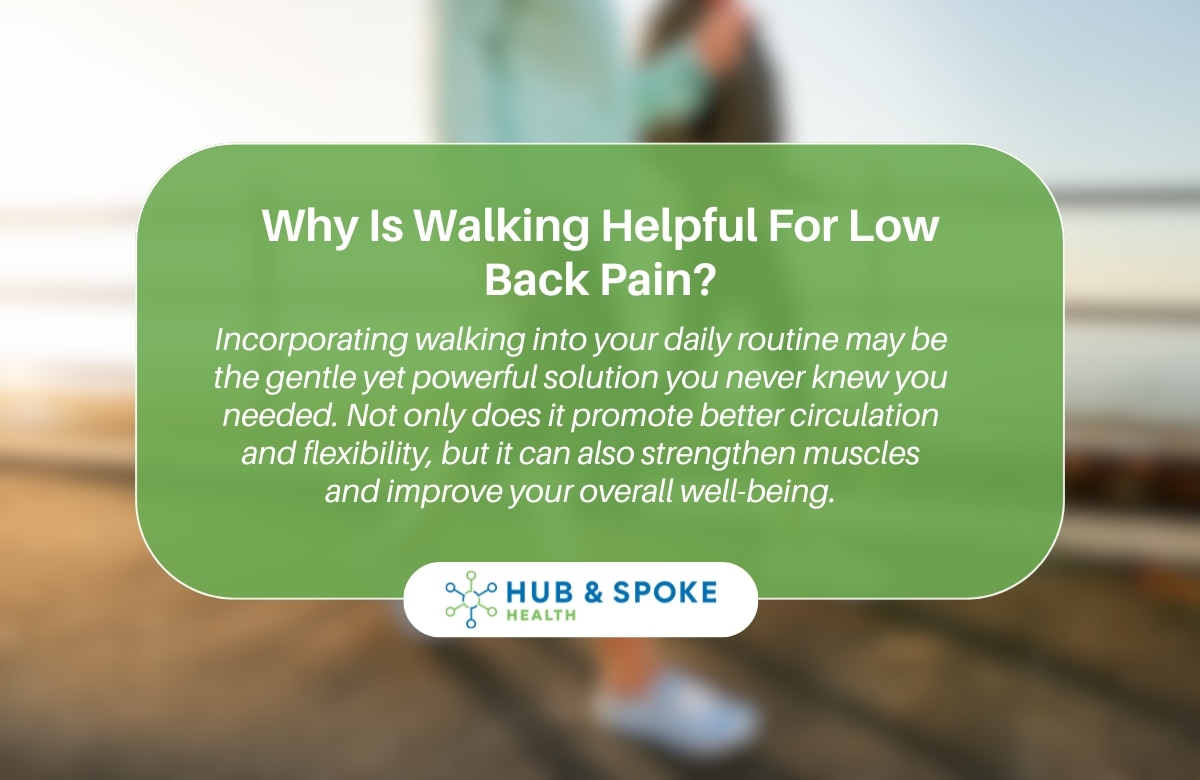Why Is Walking Helpful For Low Back Pain?
Are you tired of battling persistent low back pain that disrupts your daily life? Have you ever considered that something as simple as walking could be the key to alleviating your discomfort?
Low back pain is one of the most common ailments faced by adults today, affecting millions and often leading to significant limitations in mobility and quality of life. The big question is: how do we combat this pervasive issue effectively and sustainably? While countless treatments and therapies promise relief, many overlook one of the simplest forms of movement—walking.
Incorporating walking into your daily routine may be the gentle yet powerful solution you never knew you needed. Not only does it promote better circulation and flexibility, but it can also strengthen muscles and improve your overall well-being.
The benefits of walking for low back pain
Walking is a low-impact exercise that can be beneficial for managing low back pain for several reasons:
1. Strengthens back and core muscles
Walking engages the core muscles, including the abdominals and back muscles, which support the spine. Stronger core muscles can help improve posture and reduce strain on the lower back.
2. Improves flexibility
Walking can help increase flexibility in the hips, hamstrings, and calf muscles, which can help alleviate tension in the lower back.
3. Increases blood flow
Walking promotes blood flow to the muscles and tissues in the lower back. This can help reduce inflammation and promote healing.
4. Boosts mood
Regular exercise, such as walking, has been shown to improve mood and reduce stress. This can help alleviate the emotional impact of chronic pain.
5. Improves poor posture
Walking can help improve your posture, which can reduce strain on your back and neck.
6. Healthy weight management
Brisk walking can help with weight loss or maintenance. Excess weight can put extra strain on the lower back, so losing weight can help reduce pain.
7. Low-impact exercise
Walking is a low-impact exercise, meaning it’s gentle on your joints. This makes it a good option for people with low back pain who may be unable to do more strenuous activities.
8. Flushes out toxins
Over time, toxins can accumulate inside the body, causing pain and stiffness. When you go for a walk, your heart rate, breathing, and sweat production all rise, allowing your body to naturally eliminate toxins.
9. Manages blood pressure
Chronic low back pain increases your risk of getting high blood pressure and other cardiovascular concerns. Even a brisk ten-minute walk every day can help you control or reduce your blood pressure. When you exercise, your heart pumps harder and reduces stiffness in your blood vessels, allowing blood to flow more freely.

Risks associated with walking if you have back pain
Walking is a low-risk activity that can typically help relieve non-specific back pain. However, for the following situations, alternative ways to walk may be required.
Be cautious if you have:
1. An active back injury
A recent strain, sprain, or fracture may necessitate recovery time before you may exercise safely.
2. Spinal stenosis
Spinal stenosis can cause nerve compression and discomfort. Walking on uneven terrain or inclines may exacerbate your pain.
3. Sciatica
Sciatica pain typically affects the nerves on one side of the lower body. Walking is frequently beneficial for sciatica, however, in other circumstances, walking can worsen the pain.
4. Herniated disc
A herniated disc can also cause nerve compression and pain, which may exacerbate while walking.
Tips for walking safely to relieve back discomfort
- Walk tall, chin parallel to the ground.
- Straighten your spine and avoid slouching or leaning forward.
- Keep your shoulders down and back. Shoulder shrugs can help you relax.
- Swing your arms from the shoulders, not the elbows.
- Allow your heel to land first, then transition to rolling off your toes.
- Make sure your feet have proper support and cushioning.
- Avoid overstriding, which can cause tension in your lower leg joints.
It is crucial to note that, while walking might help with low back pain, you should listen to your body and avoid overexertion. If you are experiencing severe or prolonged low back pain, you should always consult a physiotherapist.
As a home care provider, Hub & Spoke Health helps patients achieve their physical and lifestyle goals at home, including walking with our patients.

Final thoughts
Walking is not just a simple activity—it’s a powerful ally in the fight against low back pain. By taking those steady steps, you’re not only promoting healing but also empowering yourself to regain control of your body.
And remember, a physiotherapist can be your guiding hand on this journey, providing tailored support and expert advice to ensure each stride counts.
So lace up those shoes, hit the pavement, and stroll your way to a stronger, healthier back! Your future self will thank you!
Book an appointment with us today! Our team of experts will lead you down the best treatment path for your recovery.
source https://hubandspoke.health/walking-helpful-for-low-back-pain/
Comments
Post a Comment